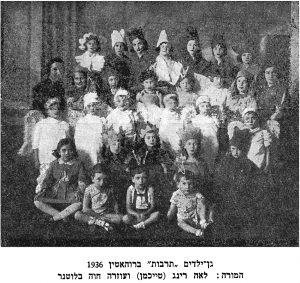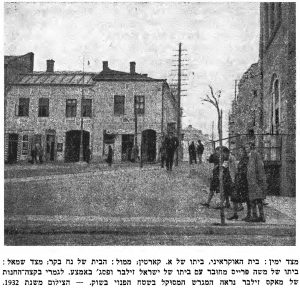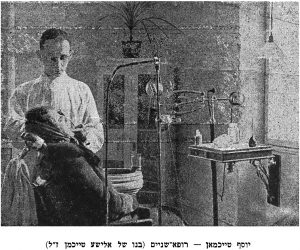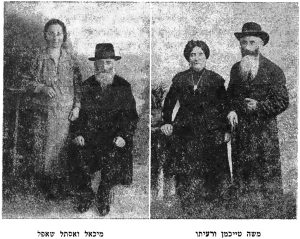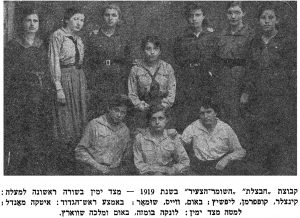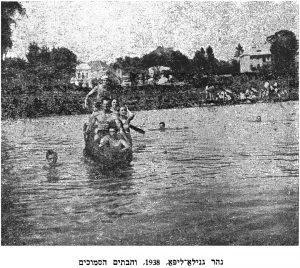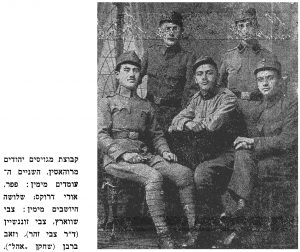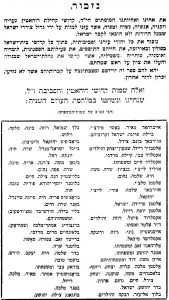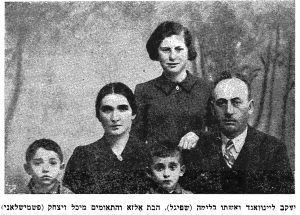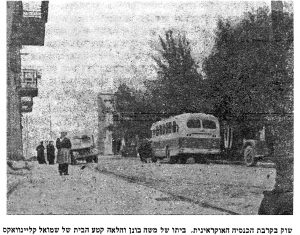![]() Ця сторінка також доступна українською.
Ця сторінка також доступна українською.
Yizkor Book for Rohatyn: The Community of Rohatyn and Environs (Kehilat Rohatyn v’hasviva); eds. M. Amitai, David Stockfish, and Shmuel Bari; Rohatyn Association of Israel, 1962 (in Hebrew). Online image version hosted by the New York Public Library and the Internet Archive. Online English version hosted by JewishGen, coordinated by Michael J. Bohnen and Donia Gold Shwarzstein.
Introduction
We shall remember all the Jews of our town and its surroundings, together with all of the martyred members of the House of Israel in Poland and Europe, their vibrant lives and their varied activities – educators and artisans, merchants and intellectuals – who kept the legacy of the House of Israel alive in exile, while placing Zion at the pinnacle of their joy. Let this book be an eternal memorial over their unknown graves, a remembrance until the last generation.
The passage above is from the pages of memorial (p.369~375) in the Rohatyn yizkor book, as translated for the JewishGen project and in Remembering Rohatyn (see below).

An original Rohatyn yizkor book, donated to the Rohatyn Opillia Museum in 2017 by Zehava Cohen-Sivan, a descendant of the Zin family of Rohatyn.
This page describes and links to a unique resource in the preservation of memory of the life and loss of the Jewish community of Rohatyn and nearby towns. Created after World War II as part of a huge international effort to commemorate the individual victims of the Holocaust in Europe and their way of life before the war, the “yizkor” (memorial) book for Rohatyn and environs was written by pre-war émigrés from Rohatyn and by Rohatyn wartime ghetto survivors. In a series of histories and sketches written in Hebrew, Yiddish, and English from personal experience and original research, the authors attempted to preserve as much as they could of the personalities, events, and modes of life of the Jews of Rohatyn, both before the war and then as the community was destroyed.
Although no such preservation effort can ever be complete, the memorial book project was successful in compiling the most comprehensive record available of Rohatyn’s 350 years of dynamic Jewish community. Its importance is evident throughout this website, as a resource in our pages on Rohatyn Jewish history and culture, as well as our heritage and project pages.
The original Rohatyn yizkor book is no longer in print; the book is available at a number of libraries and Holocaust study centers, including in the large yizkor book collections at Yad Vashem, the USHMM, and the New York Public Library. An original printed copy is also in the collection of the Rohatyn Opillia Museum, thanks to a generous donation by a Rohatyn Jewish descendant in Haifa.
Used copies of the Rohatyn edition occasionally become available through independent booksellers, and paper facsimile reprints are also available from on-demand booksellers including the Steven Spielberg Digital Yiddish Library.
Digitized image versions of the original printed book are available for free access on the website of the New York Public Library, the Yiddish Book Center, and the Internet Archive; the Internet Archive version permits download in a variety of digital formats including pdf, e-reader, and plain text with (limited) searchability.
Free access to a complete English translation of the Rohatyn book is available on the JewishGen Yizkor Book Project website.
Some of the digital access options are linked here:
Online original (image) version hosted by the NYPL
Online original (image) version hosted by the Internet Archive
Online translated (English) version hosted by JewishGen
This page also provides background information about the range of memorial books created for towns in the region of pre-war Poland; the yizkor book for Rohatyn is only one of hundreds of examples. Also included here is an overview of the contents of the Rohatyn yizkor book, its authors, and some highlights of its features.
About the Memorial Books
Beginning immediately after World War II and peaking in the 1960s, yizkor (memorial) books were composed and published in response to the Holocaust, to document the large and small histories of the Jewish communities which had been destroyed. Usually they were written, organized, and published in countries of resettlement by landsmanshaftn, fraternal and mutual aid and societies from single towns or districts of origin. A few yizkor books include articles or essays by academic historians, but the vast majority of texts were written by ordinary Jewish townspeople from a wide variety of social, religious, and professional backgrounds.
The books were typically printed in small runs of several hundred copies, intended primarily for the families of survivors of the subject town, on the assumption that there would be little interest in other groups; in most cases, the writers and their readers would be known to each other. A significant majority of yizkor books were written primarily in Hebrew with some Yiddish; smaller numbers were written primarily in Yiddish, English, or other languages. Three quarters of the books were published in Israel, followed by the US, Argentina, and other countries. Development and publication of the books largely dropped off in the 1970s, although a few new books were published later, and interest in the books continues to rise.
Estimates of total numbers vary, but at least 600 yizkor books were produced, comprising well over 150,000 pages, written by more than 10,000 authors and over 1000 editors. Most of the published books commemorate communities in the WWII bloodlands of central and eastern Europe, but significant books were also written for places in France, Greece, the Baltic states, and North Africa. The size of a pre-war settlement seems unrelated to the probability that a yizkor book would be written to commemorate it: it was as likely that a book would be written for a small town as for a large city. JewishGen has created a Yizkor Book Database to aid researchers in locating specific books in original and translated formats, including in libraries around the world.
A yizker-bukh (Yiddish) or sefer zikharon (Hebrew) is literally a memorial in book form, sometimes explicitly labeled a monument; for many of the authors and readers, a yizkor book is a matzevah, i.e. a gravestone to memorialize the people who were killed during the Holocaust, and in another sense also to memorialize the lost community and the place where it had once flourished. Yizkor books were created in parallel with other forms of commemoration, including symbolic stones placed in cemeteries in Israel and elsewhere over sacks of earth or ashes from fraternal graves in the origin towns or from death camps, memorial forests planted near new settlements of survivors, and so on. The books drew on several traditions of Jewish writing, from martyrology to community chronicle to testimony, “the need to bear witness”; for some writers, their book was a sacred text and its writing a sacred act. For other writers, their eyewitness accounts were a defense against denial and against future disasters.
Usually the books are rich in their description of a town and its people before the war, intentionally as a reference for what was lost. Many books include catalogs of the professions of Jews in the town, chronologies and genealogies of rabbis, descriptions of political and social groups, reports on interwar Zionist organizations, tales of colorful local “characters” (sometimes written in the style of Yiddish folk tales, in which anecdotes capture and carry the essence of personalities), and a large number of personal stories and reflections. In most books, there are also first- and second-hand accounts of the suffering of the town’s Jews during the war, as evidence of the catastrophe. Most yizkor books also include a necrology, a naming of the known victims of the Holocaust in or from the place. Often the books include an outline of the post-war activities of the survivors abroad, as proof that the Holocaust did not succeed in obliterating the community. Many books are also illustrated with photographs, maps, and other images from the family collections of survivors and others, linking faces and groupings to the names of the lost. Those names, images, and stories provide important data for research into the genealogy and history of families which were broken by the war.
The authors and editors of yizkor books often saw their texts as elements in a continuum of Jewish storylines. In the memorial book for the Polish town of Suwałki, Aaron Segilman writes in the English-language foreword:
It is a book written with a very familiar theme and a recurring history. The story is as old as the Bible itself. The settlement of Jews in a strange land; how they prospered and how they multiplied through the years — remaining nevertheless always strangers in a strange land no matter how long their tenure or how great the contribution to their society. Then, a time of stress and of crisis, and finally of social disorganization with its accompanying stages of humiliation, degradation and annihilation. The story varies only in degree. So was it in Egypt, so was it in Persia, so was it in Spain, so was it in Germany and so it was in Suwalk. Fortunately the familiar theme and the recurring history do not end at this point. For, no matter how great the persecution, no matter how great the violence perpetuated upon the Jewish community, there was and will always be a survival and a rebirth. So be it.
The perspective of the memorial books is always both personal and general; chronologies follow the lines of memory more than strict timelines. From an article in Judaica Librarianship in 2008 (p.47; see below):
Yizkor books reflect the post-Holocaust sensibility of descendants and survivors from the town. The books also reflect the internal politics of the survivor organizations. The sentimental views in the works are meant to show the beauty of the life that was destroyed. Written by descendants and survivors, the books are by their very nature memoiristic, and the books serve multiple purposes for the landslayt, as well as for current researchers. Dedicated to the life and death of the Eastern European Jewish hometowns, these books are considered monuments in print, destined to fulfill the purpose of commemoration. As repositories of memory, the books express what people choose to remember. The maps, the graphics, the pages of dedication, the prefaces, and other features of the books yield insights into the culture of the survivors.
A key perspective on the structure and purpose of yizkor books appears in From a Ruined Garden (p.12; see below):
[A]n important underlying dimension to the yizker-bikher is the need to re-create physical aspects of the town itself. So pronounced is this within the books as evidenced by photographs, maps, and most characteristically in the narratives themselves, that they constitute a veritable architecture of memory. To some degree the thrust behind this imaginary architecture is mnemonics. The organizers of the Kurow yizker-bukh were determined to list all the names of the town’s 3,500 Jewish residents. But how could the town’s two hundred survivors remember so many names? They sat around a table and began to review the town and its inhabitants, building by building. They then sent the list to surviving landsmen throughout the world. The final list numbered some 2,800 people.
Scholarly interest in yizkor books has varied since the 1950s; assessments of the books as source documents has changed over time. Early reviewers expressed disappointment over historical inaccuracies and bias in some of the sections, which led to an under-appreciation of the richness of the material. In later decades, researchers began to recognize the tremendous detail in the yizkor books as valuable for study in many academic and scientific disciplines.
Individual yizkor books have become valuable to more than scholars; because of the low printing numbers of original books, their rarity and desirability for genealogy and family history has made them expensive in secondary markets, and some are now stolen from library collections for personal use or resale. Fortunately, efforts by historians, archivists, and philanthropists to digitize and freely e-publish the books has helped to preserve the content of the books as a resource for all to use.
Yizkor books are now reaching readers well beyond the small circles of survivor’s families originally targeted by the writers and publishers. Extending the reach and use of the books to new groups, translation projects have made hundreds of the books available to readers who lack Hebrew and Yiddish language skills, in English and other European languages. The JewishGen translation project for yizkor books has published many of these translations online, thanks to efforts by volunteers around the world, as a resource for historians and sociologists as well as second-, third-, and fourth-generation descendants of survivors and émigrés pursuing genealogy projects.
An Overview of the Yizkor Book for Rohatyn
Since digital versions of both the original Rohatyn yizkor book and its English translation are readily available on the internet, a detailed description of the book is not necessary here. This overview will only briefly summarize the book, leaving more thorough review to the reader.
The Association of Immigrants of Rohatyn and its Surroundings in Israel (the “Rohatyn Association”) was formed in 1949 in Israel, from a community there of some 200 survivors from Rohatyn and its environs. Ten years later, the association began planning for the production of a yizkor book for Rohatyn, and to gather both content and financing. As Yehoshua Spiegel, a member of the association’s organizing committee and the book project’s lead, said in his introduction:
We turned to past residents of Rohatyn in the country and abroad… We became galvanized in the task of writing, and others responded and took an interest, some with written material and others with monetary aid. Every additional response encouraged us to continue.
Spiegel acknowledged several key contributors to the project: Dr. N. M. Gelber (historian) and the editors Mordechai Amitai (Hebrew), David Stockfish (Yiddish), and Shmuel Bari (English). Although much of the writing and editing took place in Israel, Spiegel particularly highlighted the contributions of four former Rohatyn residents in America who not only wrote for the book but also gathered additional contributors: Dr. Golda Fisher, Dr. Yitzchak Lewenter, Dr. Yaakov Faust, and Mr. Sam Henna.
The Rohatyn yizkor book was published in Israel under the direction of Mordechai Amitai in 1962.
The Hebrew/Yiddish (main) part of the book is divided into several sections:
- History of a Town (beginnings to WWI, spanning more than 50 pages)
- The Life of the City (sketches of interwar community life)
- Within the City (professions and the fair)
- Daily Life (more professions, and social activities)
- The Personalities of our Town (especially the rabbis)
- Looking to Zion (youth clubs)
- How the City Has Been Destroyed (the Holocaust in Rohatyn, more than 100 pages)
- The Surrounding Towns (Jewish communities in nearby settlements)
The book concludes with a brief description of the Rohatyn Association, and a necrology (list of victims) with more than 1000 named individuals and nearly 200 surnamed family members without given names. A sixty-page English-language section with six general and personal essays on Rohatyn’s history and the destruction of the Jewish community is also included, reading from the back of the book. Included in the history section of the book is a chapter from The Bridal Canopy, a novel written by Nobel-prize winning author S. Y. Agnon, about an amusing wedding in Rohatyn; Agnon was born and raised in nearby Buchach, and would have known Rohatyn from personal experience and visitors’ tales.
Altogether the book spans 440 pages, including more than 80 articles by almost 60 authors; some of the authors would later write and publish their own book-length personal memoirs of life in Rohatyn, including Rosette Faust Halpern and Sylvia Lederman. More than 150 photos and illustrations were included, putting faces to names and giving a sense of place to the Rohatyn the survivors remembered. Although separate yizkor books were not produced for the nearby towns and villages of Bukachivtsi, Burshtyn, Chesnyky, Verkhnia Lypytsia (Lipica Górna), Kniahynychi, Pidkamin, and Zhuriv, at least one article for each of those settlements was included in the Rohatyn “and environs” book to memorialize their communities.
In the words of the book project’s lead, Yehoshua Spiegel:
We do not deny that gaps exist in the contents of the book, and we may assume that not everything found its full expression here, but the editors of the book did what they could with the material at hand. […] You will have to forgive inaccuracies or certain duplications in the articles, as the writers are not professionals. And, after all, twenty years have passed since the time of the Holocaust, and some who wrote had already left Rohatyn thirty to forty years before. Nevertheless and despite all of these shortcomings, we are still of the opinion that the reader will feel a strong affinity and empathize with the thoughts, feelings, and memories presented here by writers who are stating facts on the pages of this book that are simple and forthright.
In the late 1990s, a group of Rohatyn survivors and descendants resolved to create an English translation of the majority Hebrew and Yiddish sections of the yizkor book, and to make that translation available for free access on the internet. Coordinated and assembled by Donia Gold Shwarzstein and Michael J. Bohnen, the new project involved lead translators Rabbi Mordecai Goldzweig and Benjamin Weiner plus a number of American and Israeli émigrés from and descendants of Rohatyn, including Jacob Hornstein, Herman Skolnick, Fay and Dr. Julian Bussgang, William Halpern, and Freda Perl. By 2001, a partial translation was on the JewishGen yizkor book translation project page, and the full translation was completed soon after. This generous donation of time and information is an important gift to anyone studying the Jewish history of Rohatyn.
Some 50 years after the original Rohatyn yizkor book was published, and more than a decade after the English-language translation was completed, Rohatyn ghetto survivor Donia Gold Shwarzstein republished a new English translation of the book in print form, with corrections for language and facts (dates, names, and more), as Remembering Rohatyn and its Environs. This book, the subject of a separate summary on our website, incorporates the original yizkor book together with an additional hundred pages of new supplementary material, including texts related to the 1998 survivors’ and descendants’ commemoration event in Rohatyn which dedicated new monuments at the Jewish mass grave sites, plus additional memorial essays, biographies of contributors to the original yizkor book, maps, and a valuable index to the original and new texts.
Additional References
Most of the information presented here is summarized directly from the English translation of the Rohatyn yizkor book, linked above, with additional clarifications provided by Donia Shwarzstein and Michael Bohnen. All images on this page are taken directly from copies of the printed book.
The background information about post-Holocaust Jewish memorial books presented here leans heavily on a few key sources. One is a journal article which evaluates the motivations, style influences, and contents of the books, and then discusses how yizkor books have been collected into libraries around the world:
Yizkor Books in the Twenty-First Century: A History and Guide to the Genre; Michlean J. Amir and Rosemary Horowitz; in: Judaica Librarianship, Volume 14, p.39~56; Association of Jewish Libraries; 2008.
One of the authors of the above article, Rosemary Horowitz, also edited a later compilation of essays about yizkor books, which includes her own concise history of the genre. Other essays in the volume include early (1950s) reviews of yizkor books during the period in which they were being produced, plus analytic studies of and using yizkor books. In the latter category, articles considering “the others” as presented in the texts of yizkor books, and the use of family photographs and other images to shape memory, add valuable insight into the genre as it influences current thinking about Jewish history:
Memorial Books of Eastern European Jewry: Essays on the History and Meanings of Yizker Volumes; edited by Rosemary Horowitz; McFarland and Company; Jefferson, North Carolina, 2011.
Additional thematic information about the memorial book genre comes from an extended review and analysis of the variety of yizkor books from towns in pre-war Poland, which also translates and compiles selections from more than sixty of the books:
From a Ruined Garden: The Memorial Books of Polish Jewry; second edition; edited and translated by Jack Kugelmass and Jonathan Boyarin; geographical index and bibliography by Zachary M. Baker; Indiana University Press; Bloomington, 1998; published in association with the United States Holocaust Memorial Museum.
Selected additional information is from the web pages of the JewishGen Yizkor Book Project and the Yiddish Book Center Yizkor Books collection.
See also Remembering Rohatyn and its Environs, compiled and edited by Donia Gold Shwarzstein, for an update and extension to the Rohatyn yizkor book.
This page is part of a series on memoirs of Jewish life in Rohatyn, a component of our history of the Jewish community of Rohatyn.

